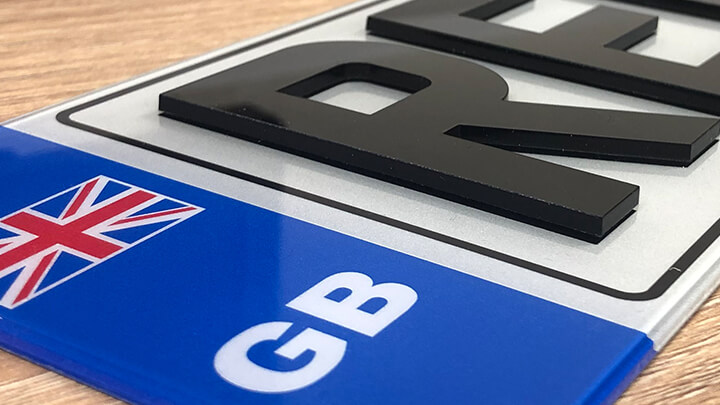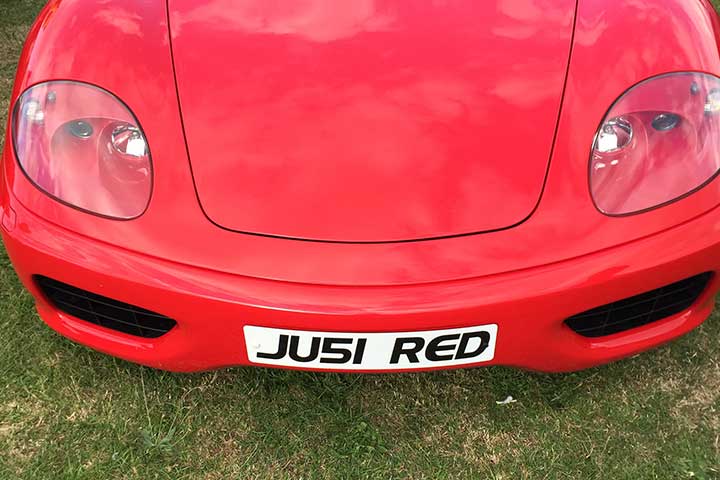Number plate rules and regulations
Required
- White front plate (to British Standard BS AU 145e);
- yellow rear plate (to British Standard BS AU 145e);
- characters in the mandatory font (black 'Charles Wright 2001');
- spacing of characters and character groups in accordance with the measurements specified in the regulations;
- details of plate manufacturer and supplier
Optional
- '4D' (raised 3D characters) variation of the mandatory 'Charles Wright 2001' font coloured, non-reflective border;
- coloured, non-reflective border;
- national emblem: English St George Cross with "ENG" identifier, Scottish St Andrew Cross with "SCO" identifier, Welsh Dragon with "WALES" and "CYMRU" identifier, British Union Flag with "UK" or "GB" identifier);
- green flash (panel) only for electric vehicles.
Not permitted
- Fancy or decorative typefaces;
- Bolts placed in such a way as to alter the appearance of characters;
- Adjusted spacing between characters or character groups;
- Altered characters;
- additional logos or symbols, such as sporting emblems and religious symbols;
- any other alteration or addition not permitted in the British Standard and regulations.
For full details and specifications, see our main number plates rules and regulations page.
Acrylic plate options
When you purchase a private registration from Regtransfers we are also able to supply high-quality acrylic number plates.
Regtransfers offers all legal number plate options, including coloured borders, UK national flags, and green-flash number plates for electric vehicles. We can also supply '4D' number plates with genuine, raised three-dimensional characters.
Our full range of number plate options is presented during the online purchase process for your private registration. Simply choose what you want to see on your new acrylic number plates.

When you buy your acrylic plates from Regtransfers, we will already have seen the legally required proof of identity and entitlement when we transfer your new registration. If you purchase from another supplier you will need to produce several documents to prove your identity and entitlement to the plates.
Regtransfers does not supply any options that do not comply with current regulations.
For more information on the regulations relating to optional features on number plates, please see our main number plates rules and regulations page.
Additional information on what defines an illegal number plate can be found via our page on illegal number plates.
Replacing and fitting acrylic plates
Acrylic plastic number plates are pretty tough, but they do occasionally get damaged, broken or even stolen. Here's how to fit new acrylic plates to your vehicle.
Buying replacement number plates
If you need to buy replacement number plates, the law says that you must produce documents to prove your identity and your entitlement to display the registration number on a vehicle.
Furthermore, only officially registered suppliers are allowed to make and sell registration plates.
To ensure that your replacement plates comply with the law, please see our full guide to buying replacement number plates. You will find full details there of the documentation you will need, and tips on how to avoid buying from an illegal source.
While Regtransfers can supply acrylic plates with your private registration number at the point of sale, we are unable to sell replacement number plates later on.
Removing old acrylic plates
Remove the old number plates from the car. If they are screwed in place then simply remove or open the plastic screw covers (if present) and undo the screws. Keep the screws in case any new screws are too small for the existing mounting holes.
If the plate is secured with double sided pads or tape you'll have to work it loose. This can take a while as the mounting pads use very strong adhesive. Pull/prise the plate away from the car keeping up a consistent force. You may find that a tool such as a wallpaper scraper can be inserted behind the plate to help loosen it.
Mounting acrylic plates
NB: this guide refers to fitting or changing the physical plastic number plates on a vehicle. If you wish to change the registration number of the vehicle you must learn how to transfer private plates.
Acrylic show plates
Show plates are number plates that are sometimes used to replace a car's normal, road-legal registration plates for a special event or display, such as a car show.
Show plates can display a name, a word, a logo or almost anything but they are purely for display off the public highway. Show plates are not legal for use on the road.
Regtransfers does not sell or supply show plates.

Confusion and risks
As show plates are not used on the road, they are not governed by the regulations that apply to 'real' number plates. Manufacturers of show plates do not have to use legal fonts, spacing or even materials.
For this reason, it may not be safe to purchase number plates for road use from a supplier of show plates. Plates manufactured as show plates may well not meet the standards that the law requires for road use and may, therefore, be illegal to use on the public highway, even if they show the correct registration number. The penalties for driving on the road with show plates on your vehicle would be the same as for driving with any other illegal number plates: a fine and/or MOT failure and/or the loss of your private registration number.
Our top tip: In order to avoid inadvertently displaying illegal number plates on your vehicle, Regtransfers strongly recommends that you buy your number plates for on-road use from a government-registered supplier of acrylic number plates.
Disposal of number plates
Please dispose of unwanted acrylic number plates responsibly.
Before recycling or disposing of plates, you should render them unusable by cutting or breaking to prevent misuse by criminals. Acrylic can be cut with a saw and can be broken with a heavy hammer (with some difficulty). Destruction should be carried out safely and carefully, and appropriate protection should be worn, such as gloves, goggles, dust masks etc.
Acrylic plastic is recyclable but not easily. It is a Group 7 plastic and not all local authority recycling centres are equipped to accept it. Your local recycling centre will be able to tell you if they can deal with acrylic.
If your local council facility cannot recycle acrylic products, there are commercial companies throughout the UK who will. Google "Acrylic recycling near me".
Share this...